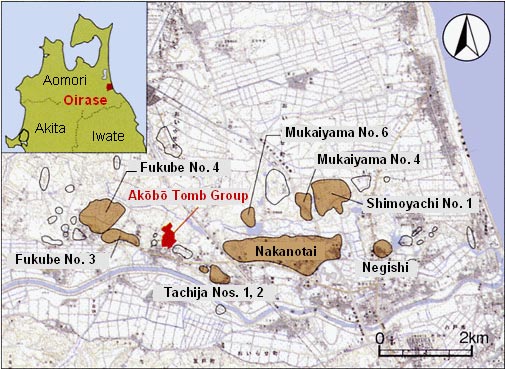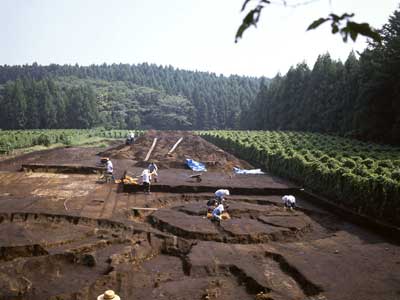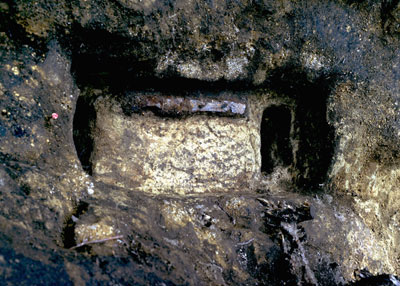Akōbō:
Built continuously over a 300 year period, the largest-scaled group of “final mounded tombs.” Were influential figures of the surrounding area buried here?

Site location map The vicinity of the Akōbō tomb group is dotted with sites of the same period. It is thought that people from these settlements were buried there.

A view of the excavation Round mounds are massed in the middle of a farmer’s field. |

A round mound under excavation This mound was discovered during excavation in the midst of a wooded area. The fill of the mound has survived well, and the rectangular pit in which the coffin was placed is visible in the center. |

Schematic diagram of a round mound (Tenjin’yama No. 2)
A sword with a curled fern frond ornament on the hilt, an iron knife, and a bracelet were recovered from within the facility for interring the corpse, and pottery and iron objects from the outside.

A pit burial The construction is the same as used for burial facilities in round mounds. A sword was recovered.

A sword with a curled fern frond ornament on the hilt The end of the hilt is curled in the manner of a fern frond. These swords were commonly made from the Asuka to the Heian periods. The handguard is made of bronze, and the hilt is cord-wrapped. Recovered from the Tenjin’yama No. 2 mound. Length: 56 cm.

Magatama (curved bead) Made of agate; recovered from the Tenjin’yama No. 4 mound. Length: 2.9 cm. |

Sue ware Recovered from the ditch surrounding the Tenjin’yama No. 2 mound. The short-necked vase in the center has a hole in its base, and as the corresponding sherd has not been recovered, the hole was possibly made deliberately. |
Akōbō Tomb Group, Oirase Town, Aomori Prefecture
“Akōbō tomb group” is an inclusive label for the mounded tomb clusters located in the Akōbō, Tenjin’yama, and Jūsanmori (2) sites. They are located atop a terrace 40 m in elevation, on the northern side of the lower basin of the Oirase river as it flows through the southeastern portion of Aomori prefecture into the Pacific, and approximately 70 km inland from the coast. Centered on the tomb group, settlements of the same time period spread out to the east and west.
Sixteen excavations have been conducted from 1988 through 2005, and 108 “final mounded tombs,” plus 8 pit burials (tombs lacking a surrounding ditch) were discovered. They are thought to have been made in continuous fashion from the beginning of the seventh to the end of the ninth centuries.
Round tombs and pit burials
“Final mounded tombs” are a type of burial made in the northern part of Tōhoku from the seventh century on, when the ancient Japanese state extended its influence to the region, and as a result of its influence people called the “Emishi” built mounded graves mainly from the seventh to the ninth centuries. The final mounded tombs in the Akōbō group are round mounds about 1 m in height and ranging from 4 – 8.9 m in diameter, and surrounded with ditches approximately 1 m wide. The ditches include those complete encircling the mound, and those leaving a bridge-like portion at one spot where the ditch was not dug.
Final mounded tombs basically contain a burial of a single individual, made by digging a rectangular pit in the center of the mound and laying a wooden coffin within it, and covering it with a lid.
Pit burials have no encircling ditch, and while the burial facilities are similar to those of final mounded tombs, they are slightly smaller in size.
Artifacts recovered from the burials divide into those inserted in the coffin, and those placed in the surrounding ditch, on top of the coffin, or on the mound; the former include long swords, swords with a curled fern frond ornament on the hilt, iron projectile points, sickles, axes, beads, earrings, and bracelets, while the latter are centered on Sue ware (unglazed stoneware) and Haji ware (earthenware), and include equestrian gear, and iron tips for spade and hoe blades.
Distribution of final mounded tombs
Final mounded tombs are distributed from Miyagi prefecture north to the Ishikari Lowlands in Hokkaido, and in addition to those containing a wooden coffin in a pit in the manner of Akōbō, there some which utilize a stone chamber, but there are similarities between these types in scale and in the artifacts recovered.
Akōbō is the largest tomb group among the type having wooden coffins in pits, and the period over which it was in use is also the longest. Further, as final mounded tombs were originally very low in height, in many cases the mound was completely destroyed during agricultural development leaving no trace on the ground surface, so from the more than sixty of its mounds still surviving, Akōbō’s good state of preservation is also one of its characteristics. (Koyachi Hajime)
